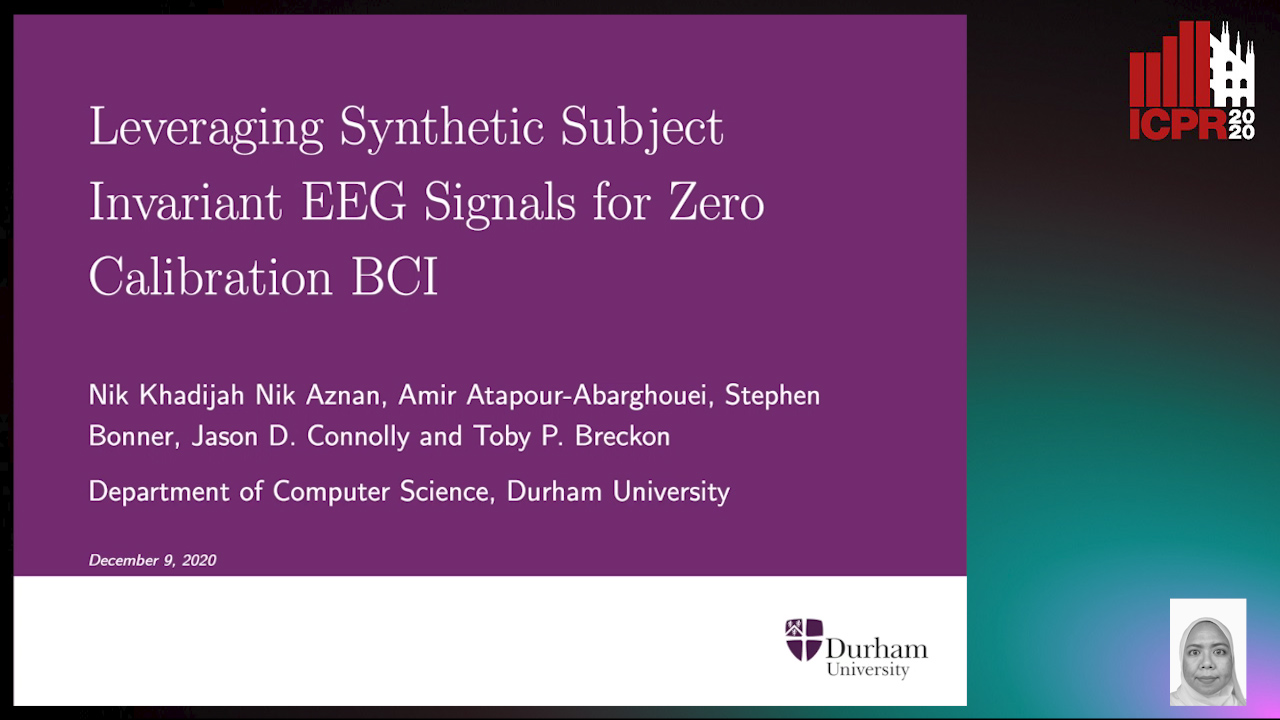Amir Atapour-Abarghouei
Paper download is intended for registered attendees only, and is
subjected to the IEEE Copyright Policy. Any other use is strongly forbidden.
Papers from this author
Leveraging Synthetic Subject Invariant EEG Signals for Zero Calibration BCI
Nik Khadijah Nik Aznan, Amir Atapour-Abarghouei, Stephen Bonner, Jason Connolly, Toby Breckon

Auto-TLDR; SIS-GAN: Subject Invariant SSVEP Generative Adversarial Network for Brain-Computer Interface
Recently, substantial progress has been made in the area of Brain-Computer Interface (BCI) using modern machine learning techniques to decode and interpret brain signals. While Electroencephalography (EEG) has provided a non-invasive method of interfacing with a human brain, the acquired data is often heavily subject and session dependent. This makes seamless incorporation of such data into real-world applications intractable as the subject and session data variance can lead to long and tedious calibration requirements and cross-subject generalisation issues. Focusing on a Steady State Visual Evoked Potential (SSVEP) classification systems, we propose a novel means of generating highly-realistic synthetic EEG data invariant to any subject, session or other environmental conditions. Our approach, entitled the Subject Invariant SSVEP Generative Adversarial Network (SIS-GAN), produces synthetic EEG data from multiple SSVEP classes using a single network. Additionally, by taking advantage of a fixed-weight pre-trained subject classification network, we ensure that our generative model remains agnostic to subject-specific features and thus produces subject-invariant data that can be applied to new previously unseen subjects. Our extensive experimental evaluation demonstrates the efficacy of our synthetic data, leading to superior performance, with improvements of up to 16% in zero-calibration classification tasks when trained using our subject-invariant synthetic EEG signals.
On the Impact of Lossy Image and Video Compression on the Performance of Deep Convolutional Neural Network Architectures
Matt Poyser, Toby Breckon, Amir Atapour-Abarghouei

Auto-TLDR; The Impact of Lossy Image Compression on Deep Neural Networks for Image-based Detection and Classification
Recent advances in generalized image understanding have seen a surge in the use of deep convolutional neural networks (CNN) across a broad range of image-based detection, classification and prediction tasks. Whilst the reported performance of these approaches is impressive, this paper investigates the hitherto unapproached question of the impact of commonplace image and video compression techniques on the performance of such deep learning architectures. Focusing on the JPEG and H.264 (MPEG-4 AVC) as a representative proxy for contemporary lossy image/video compression techniques that are in common use within network-connected image/video devices and infrastructure, we examine the impact performance across five discrete tasks: human pose estimation, semantic segmentation, object detection, action recognition, and monocular depth estimation. As such, within this study we include a variety of network architectures and genres spanning end-to-end convolution, encoder-decoder, region-based CNN (R-CNN), dual-stream, and generative adversarial networks (GAN). Our results show a non-linear and non-uniform relationship between network performance and the level of lossy compression applied. Notably, performance decreases significantly below a JPEG quality (quantization) level of 15% and a H.264 Constant Rate Factor (CRF) of 40. However, re-training said architectures on pre-compressed imagery conversely recovers network performance by up to 78.4% in some cases. Furthermore, there is a correlation between architectures employing an encoder-decoder pipeline and those that demonstrate resilience to lossy image compression. The characteristics of this input compression to output performance impact can be used to inform design decisions within future image/video devices and infrastructure.